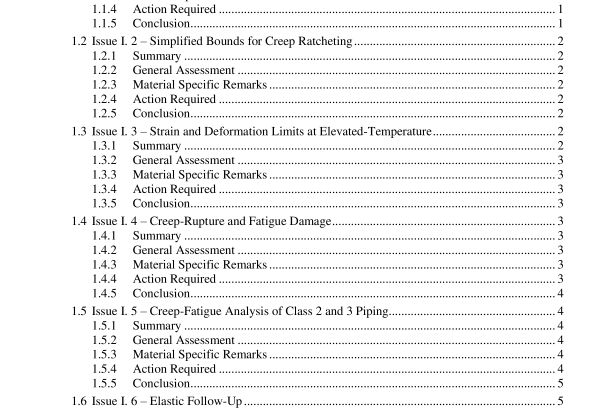ASME NTB-3-2020 pdf free download.Gap Analysis for Addressing Adequacy or Optimization of ASME Section III, Division 5 Rules for Metallic Components
1.1 Issue I. 1 – Identify Areas Where Appendix T Rules are not Met
1.1.1 Summary
O’Donnell, Hull and Malik [1] summarized this issue in Item OG- 10 as follows: Appendix T in NH [7] provides three expressions for determining strain range [8] using elastic analysis and, if these rules cannot be satisfied, additional rules are provided, presumably less conservative, based on the results of inelastic analyses which require detailed constitutive models of material behavior under time varying loading conditions. For the CRBR, these behavioral models were a contractual provision based on RDT Standards. These applicable standards are no longer maintained and there have been numerous technical developments in this area since then [9]. Appendix T rules cover strain, deformation, creep and fatigue limits at elevated temperatures for 304SS/316 SS (816C), Alloy 800H (760C), 2.25Cr-1Mo (593C), 9Cr-1Mo-V (649C). Development of material models for materials not currently covered or for temperatures beyond their original range of verification will be a considerable effort. Modifications in Appendix T rules for higher temperatures and additional materials (e.g., Alloy 617, Hastelloy X/XR) may be needed.
1.1.2 General Assessment
Appendix HBB-T of BPVC Section III, Division 5 provides procedures to evaluate strain limits and creep fatigue damage using elastic analysis. Alternatively, for some Class A materials, recent code cases provide procedures based on Elastic-Perfectly plastic (EPP) analysis. If these rules cannot be satisfied, additional rules are provided which are based on results of inelastic analyses. However, inelastic analysis requires detailed constitutive models of material behavior under time varying loading conditions. For the CRBR, these behavioral models were based on Nuclear Standard NE F9-5T. This standard is no longer maintained, and numerous technical developments have been made since. However, ASME has established a working group to develop inelastic analysis methods and constitutive models for Class A materials for incorporation into BPVC Section III, Division 5. Models for several materials have been developed and are ready for ASME Code action [10], and the development process continues in the working group for the remaining materials.
1.1.3 Material Specific Remarks
None.
1.1.4 Action Required
(1) Complete the extension of the EPP methods to the remaining Class A materials, and (2) proceed to ballot the recommended constitutive equations developed in the Working Group on Analysis Methods.
1.1.5 Conclusion
Categorized as Optimization.
1.2 Issue I. 2 – Simplified Bounds for Creep Ratcheting
1.2.1 Summary From O’Donnell, Hull and Malik [1] Item OG- 5: The Draft Code Case for Alloy 617 imposes ratcheting strain limits that are similar to the limits given in Subsection NH, but is restricted to an upper temperature limit of 649 o C. Simplified ratcheting evaluation procedures require development for temperatures above 649 o C [11].
New work has been proposed to ensure that recent technology developments are incorporated [9]. Huddleston and Swindeman stated this issue in Item HS- 13 as “difficult, overly conservative ratcheting design rules” and noted that the rules have been improved since the CRBRP to include applicability to structural discontinuities and application to nonaxisymmetric geometries and nonlinear temperature gradients. It is considered a design basis economic issue and is not included as one of the top ten major issues.
1.2.2 General Assessment
The current strain accumulation rules have geometric and service level transient design restrictions. The rules are also complicated to apply. The BPVC Section III, Division 5 elastic rules for strain limits evaluation are based on the decoupling of creep and plasticity. For temperatures above a certain cut off, the decoupling of creep and plasticity can no longer be justified and a unified viscoplastic model is necessary to describe the deformation behavior. The recently developed EPP methodology for strain limits evaluation of Type 304 and 316 stainless steels does not depend on the decoupling of creep and plasticity. It has been demonstrated by tests to be applicable to the full temperature range permitted code allowable stresses, including very high temperatures where creep and plasticity are no longer decoupled. Cut off temperatures for the Class A materials have recently been established [12].ASME NTB-3 pdf download.ASME NTB-3-2020 pdf free download
